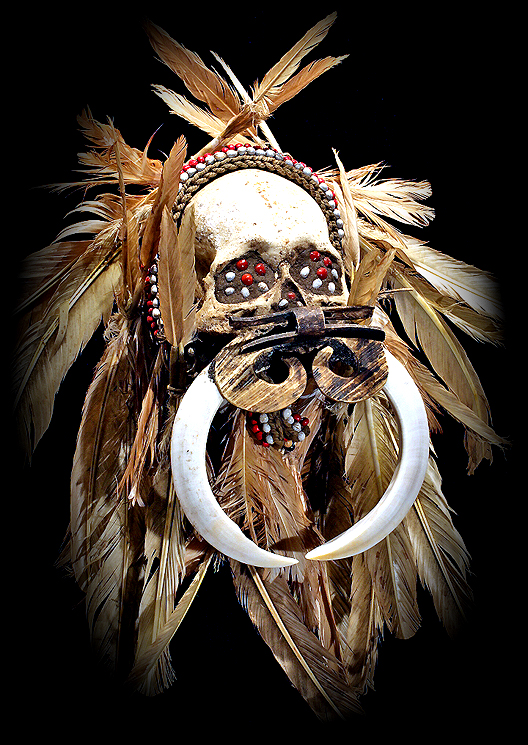
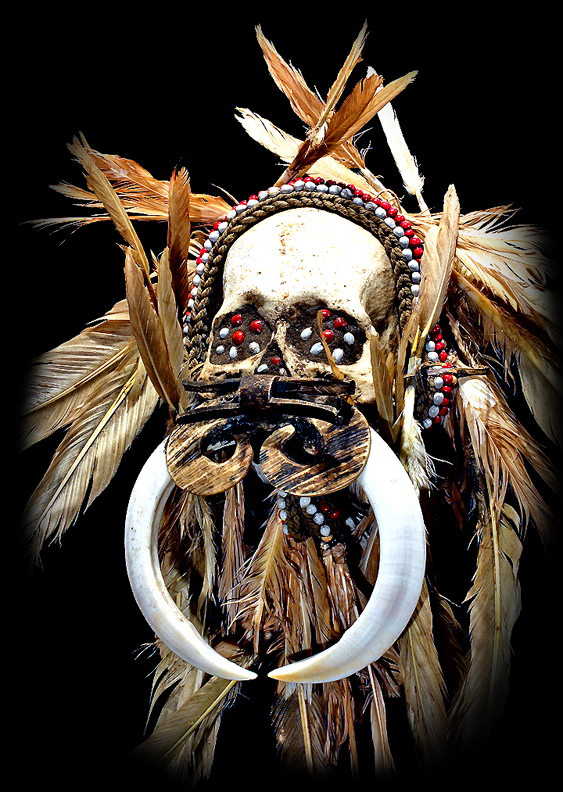
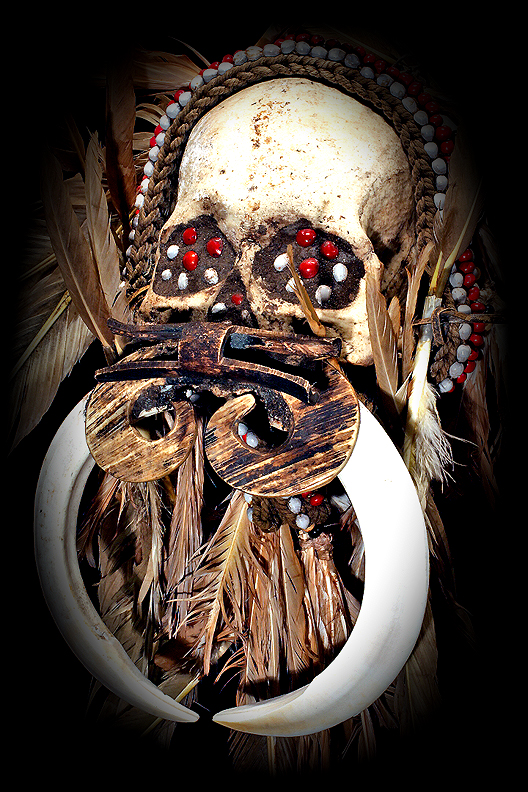
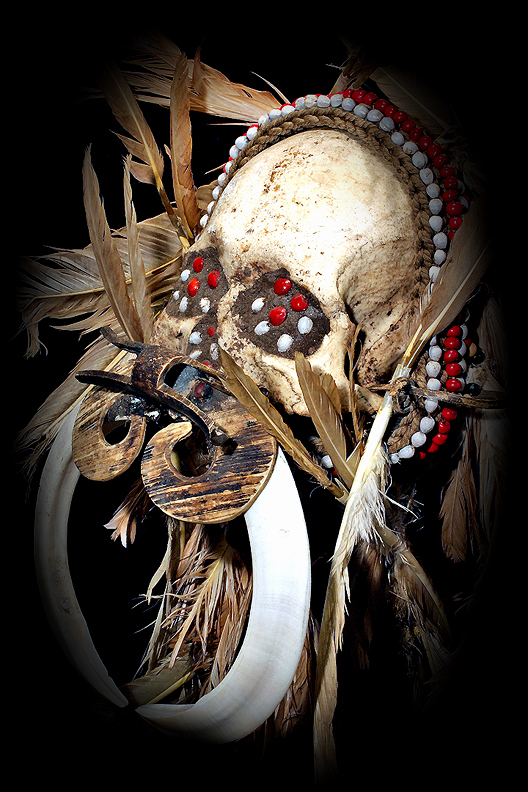
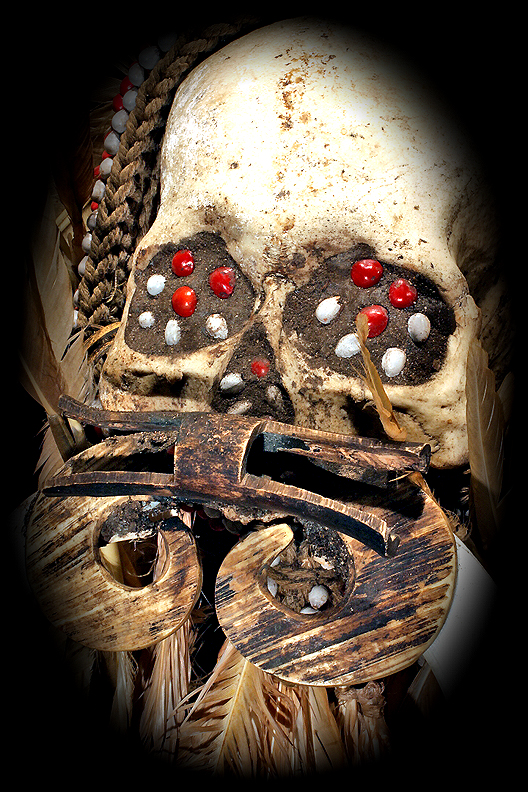
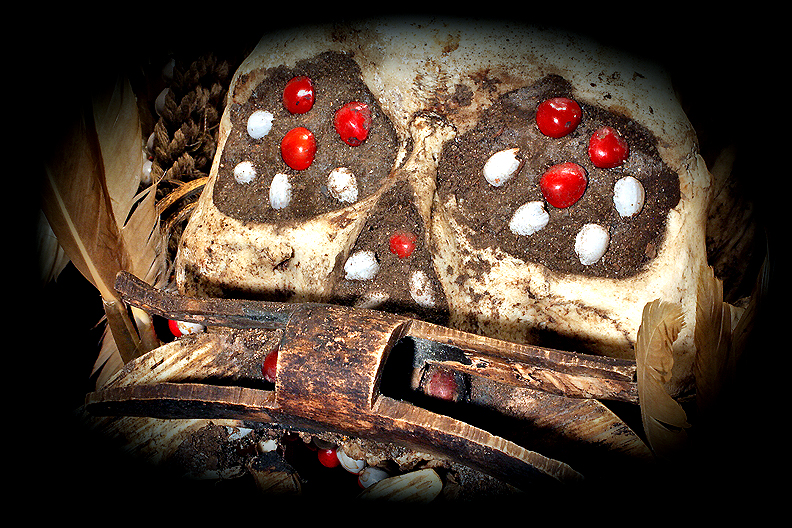
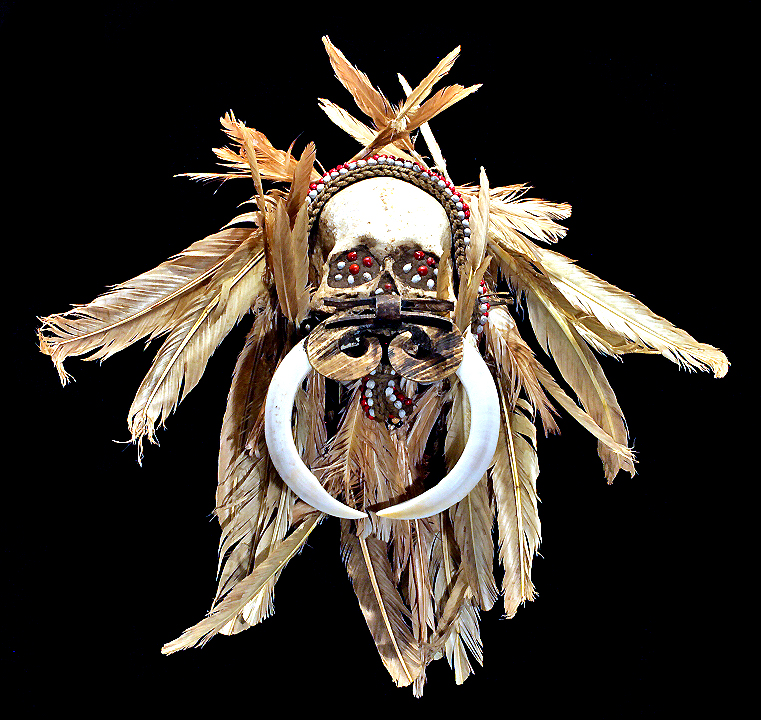


HUMAN BONE, HAND WOVEN FIBER RED AND BLACK BEADED AND WHITE
SEEDED HEAD BAND, INLAID
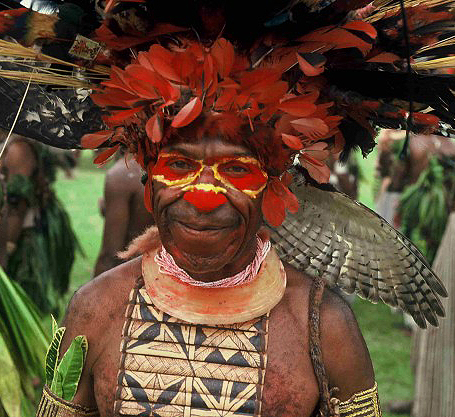
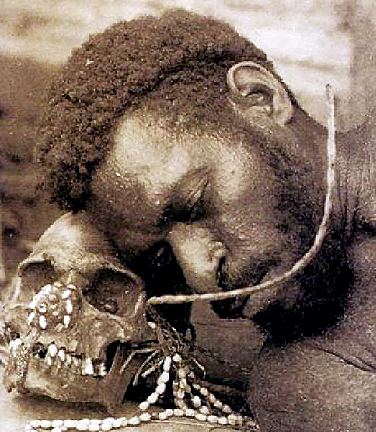
|
HUMAN ANCESTOR SKULL #31 |
         HUMAN BONE, HAND WOVEN FIBER RED AND BLACK BEADED AND WHITE SEEDED HEAD BAND, INLAID   |
|
Papua. Known to use human skulls under their heads for pillows, they also have been reported to eat human brains mixed with sago worms straight from halved human skulls. The Asmat live in mangrove vegetation near the sea and rivers, on the south side of the western part of New Guinea. The Asmat, in addition to hunting for skulls, also worshipped them. Ancestor skulls are stripped of brains and eyes! Nasal passages are closed to prevent evil spirits from entering or exit the body. Asmat decorated skulls are displayed in sacred places inside Asmat domiciles. Headhunting raids are an important element of Asmat culture until missionaries suppressed the practice. The death of an adult, even by disease, was believed to be caused by an enemy, and relatives sought to take a head in an endless cycle of revenge and propitiation of ancestors. Heads were thought necessary for the rituals in which boys were initiated into manhood. Cannibalism was a subsidiary feature of the rituals that followed the taking of heads. It was not until Catholic missionaries established an out post in 1953 that significant interaction with the Asmat people began. Catholic missionaries, many with degrees in anthropology, were partially successful in persuading some of the Asmat to stop cannibalism and headhunting, while encouraging the continuation of other important cultural cycles and festivals such as shield and bisj ceremonies, which were incorporated into an adapted Catholic liturgy. Asmat was the launching point for an arduous joint French-Dutch expedition from the south to north coast of New Guinea in 1958 and 1959, which was documented by the team and resulted in a book and documentary film, The Sky Above, The Mud Below, which won an Academy Award in 1962. In November 1961, the 23-year-old Michael Rockefeller, son of the then-Governor of New York Nelson Rockefeller and member of one of the wealthiest families in the United States, disappeared in Asmat when his boat overturned while on an art collecting expedition. His disappearance, followed by an intensive and ultimately unsuccessful search by the Dutch authorities, was the source of much speculation as to Mr. Rockefeller's fate. Recently, author Carl Hoffman in his book "Savage Harvest," presented evidence that Rockefeller was killed and eaten by people from Otsjanep village. David Howard's photography and tribal art were featured on the cover of Smithsonian Magazine when Hoffman's book, concerning Rockefeller, was reviewed in March 2014. In 1962, the Indonesian government took over administration of western New Guinea. After a short period under the new Indonesian administration from 1964 to 1968 in which Asmat cultural ceremonies were officially discouraged, local Bishop Alphonse August Sowada was instrumental in facilitating the revitalization of woodcarving and other festivals, which remain strong today. The church, along with Tobias Schneebaum and Ursula Konrad, established the Asmat Museum of Culture and Progress (AMCP) in the local town of Agats in 1973, to maintain local pride in Asmat cultural traditions. Each year in early October, the church sponsors a woodcarving competition and auction to recognize outstanding carvers.  THE ASMAT TRIBE ATTACH FEATHERS, SEEDS, AND CARVED SEA SHELL NOSE RINGS TO THEIR DECEASED ANCESTOR'S SKULLS AND USE THEM AS PILLOWS WHEN SLEEPING. The first apparent sighting of the Asmat people by explorers was from the deck of a ship led by a Dutch trader, Jan Carstensz in the year 1623. Captain James Cook and his crew were the first to actually land in Asmat on September 3, 1770 (near what is now the village of Pirimapun). According to the journals of Captain Cook, a small party from the HM Bark Endeavor encountered a group of Asmat warriors; sensing a threat, the explorers quickly retreated.  Asmat art, most noticeably elaborate, stylized wood carving, is designed to honor ancestors. Many Asmat artifacts have been collected by the world's museums, among the most notable of which are those found in the Michael C. Rockefeller Collection at the Metropolitan Museum of Art in New York City and the Tropen Museum in Amsterdam. One of the most comprehensive collections of Asmat Art can be found in the American Museum of Asmat Art at the University of Saint Thomas in St. Paul, Minnesota. Until the 1950s, their remote and harsh location isolated the Asmat from other peoples. It was not until the mid-20th century that they came into regular contact with outsiders. The Asmat were documented headhunters and cannibals, and as a consequence were left largely undisturbed until the mid-20th century. Traditionally, many Asmat men practiced polygamy by marrying more than one woman. In many cases, men were expected to marry a male relative's wife when that relative dies (otherwise the woman and her children would be left without a source of protection or economic support). Many Asmat men had long-term ritual sexual/friendship relationships with other men, although the prevalence of this practice has been disputed by others. In the mbai system, male partners were also known to share their wives in a practice called papitsj. The natural environment has been a major factor affecting the Asmat, as their culture and way of life are heavily dependent on the rich natural resources found in their forests, rivers, and seas. The Asmat mainly subsist on starch from the sago palm (Metroxylon sagu), fish, forest game, and other items gathered from their forests and waters. Materials for canoes, dwellings, and woodcarvings are also all gathered locally, and thus their culture and biodiversity are intertwined. Due to the daily flooding which occurs in many parts of their land, Asmat dwellings have typically been built two or more meters above the ground, raised on wooden posts. In some inland regions, the Asmat have lived in tree houses, sometimes as high as 25 meters from the ground. The Asmat have traditionally placed great emphasis on the veneration of ancestors, particularly those who were accomplished warriors. Asmat art, most noticeably elaborate, stylized wood carving, is designed to honour ancestors. Many Asmat artifacts have been collected by the world's museums, among the most notable of which are those found in the Michael C. Rockefeller Collection at the Metropolitan Museum of Art in New York City and the Tropenmuseum in Amsterdam. ANCESTOR SKULLS ARE COLLECTED AND VENERATED TO REMEMBER DECEASED FAMILY MEMBERS. THE IFUGAO COLLECT BONES OF DEAD RELATIVES; WRAP THEM IN TRIBAL TEXTILES, AND STORE THEM IN THE RAFTERS UNDER THEIR HUTS. HUMAN SKULLS AND SKULL CAPS FROM NEPAL ARE RITUAL OFFERTORY VESSELS THAT ARE USED AS DRINKING CUPS IN TIBETAN BUDDHIST CEREMONIES. |
| |
Asian tribal art, artifacts, ifugao, kalinga, bontoc,
asmat, dayak, philippines, asia, head hunters, human trophy skull,
skulls, african, antiques, naga, necklace, headdress, head hunting
trophy skull, Indonesia, Indonesian, SOUTHEAST ASIA, Borneo, Sarawak,
ANTIQUES, Kalimantan, Sulawesi, ART, Sumatra, Timor, ARTIFACTS, Bali,
Java, INDIA, Flores, Sumba, NEPAL, Savu, Roti, BABAS, Lombok, Malaysia.
HOLY MEN, Nusa Tengara, New Guinea, SHAMAN, Irian Jaya, Moluccas,
CONTEMPORARY ART, Tanimbar, Leti, OLD, Lembata, Alor, MINILA,
Philippines, Luzon, PALAWAN, Mindanao, Sulu, BLOW GUN, Southeast Asia,
Asia, NOSE RING, Asian, Burma, HAT, Myanmar, India, SWORD, Nagaland,
Nepal, KNIFE, Tibet, Himalaya, MOUNTAIN, Himalayan, Assam, TRIBES,
Thailand, Vietnam, YAO, Yunnan, Hainan,
HMONG, China, Central Asia, ZAO, Dayak, Batak, BAG, Toraja, Naga,
POLE, Chin, Li, QUIVER, Miao, Bahau, MASK, Punan, Penan, MODELED SKULL,
Modang,
Kayan, BRASS COIL, Kenyah, Ngaju, COILS, Kontu, Kantu, TEXTILE, Iban,
Maloh, PRIEST, Tunjung, Busang, RITUAL, Aoheng, Dong Son, MYSTICAL
Konyak, Tangkhul, MYSTIC, Ao, Angami, PRIMITIVE, Sema, Wancho, HAND
MADE,
Bontoc, B'laan, ARTIST, Bagabo, Gaddang, BULUL, Ifugao. Sculpture,
BULULS, statue, mask, BOX, beadwork, bead, AUTHENTIC, textile, weaving,
TRIBAL,
costume, hat, WOODEN, shield, spear, WOOD, helmet, sword, BOAR, charm,
fetish, FEATHERS, drum, basket, FEATHER, basketry, jewelry, SILVER,
ornament, weapon, ASMAT Canoe, amulet, decoration, SCULPTURAL,
architecture, architectural, SCULPTURE, longhouse, headhunter, SKULL,
headhunting,
shaman, TRIBAL, festival, ceremony, ceremonial, SHAMAN ritual, tattoo,
HEAD HUNTER Skull, dragon, hornbill, HEADDRES, art, tribal, VIETNAM,
tribe,
culture, TRIBES, cultural, myth, TRIBAL, artifact, artefact, REAL,
wood, stone, HAND WOVEN, cotton, metal, CAST bronze, brass, cloth,
ISLAND, tropics, tropical, EQUATOR, ethnographic, EQUATORIAL, Tribal
Art,
Primitive Art, Ethnographic Art, Oceanic Art, Folk Art, Ethnic
Cultures,
AUTHENTIC Artifacts, Textiles, ANCIENT, Costumes, Sculpture,
SCULPTURES,
Masks, Beadwork, BEADS, Fetishes, Charms, GOLD Jewelry, Baskets,
BAMBOO,
Weapons, Shields, ORNATE, Indonesia, Borneo, PUPPETS, Sumatra,
Sulawese,
SHADOW PUPPET, Java, Bali, CAVE, Timor, Flores, ISLAND, Sumba. Lombok,
VILLAGE, Molucca, Philippines, RICE TERRACE, Luzon, Mindanao, DAVID
HOWARD
PHOTOGRAPHY, Nepal, Burma, SACRED JOURNEY: THE GANGES TO THE HIMALAYAS,
Thailand, THE LAST FILIPINO HEAD HUNTERS, Laos, Vietnam, TEN SOUTHEAST
ASIAN
TRIBES FROM FIVE COUNTRIES, India, Central Asia, NECKLACES, Southeast
Asia,
Dayak, STATUE, lban, Kayan, INK STAMP, Kenyah, Modang, FEATHERED,
Bahau, Ngaju, HORSE, Batak, Toraja, NAGALAND, Naga, Dong Song. TRIBAL
ART, AUTHENTIC PRIMITIVE ART, OLD ETHNOGRAPHIC ART, RARE OCEANIC ART,
BEAUTIFUL FOLK ART, ETHNIC CULTURES, TRIBAL ARTIFACTS, TEXTILES,
ASIAN,
COSTUMES, SCULPTURE, WOOD MASKS, BEADWORK, CHARMS, FETISHES, SIVER
JEWELRY BOXES, BASKETS, WEAPONS, FILIPINO SHIELDS, INDONESIA, BORNEO,
ETHNOGRAPHIC, SUMATRA, SULAWESE, TRIBAL, JAVA, BALI, TRIBES, TIMOR,
FLORES, ASIAN,
SUMBA. LOMBOK, TRIBES, MOLUCCA, PHILIPPINES, TRIBAL, LUZON, ASIAN,
MINDANAO, NEPAL, ASIA, BURMA, THAILAND, TRIBAL, LAOS, VIETNAM, TRIBES,
INDIA,
CENTRAL TRIBAL ASIA, ARTIFACTS, SOUTHEAST ASIA, HEAD HUNTER, DAYAK,
ASIAN, IBAN, KAYAN, TRIBE, KENYAH, MODANG, TRIBAL, BAHAU, NGAJU, ASIAN,
BATAK, TORAJA, TRIBE, NAGA, tribal art, ASIAN, primitive art, ASIA,
ethnographic
art, TRIBAL, oceanic art, ASIAN folk art, SOUTHEAST ASIA ethnic
cultures,
artifacts, ASIAN, textiles, costumes, VILLAGE sculpture, masks, TRIBAL
beadwork, fetishes, TRIBES charms. jewelry, TRIBE, baskets, weapons,
TRIBAL,
shields, indonesia, ASIAN, borneo. sumatra, TRIBAL ART sulawese, java,
HILL TRIBE, bali, timor, ASIAN, flores, sumba, TRIBES, lombok, molucca,
BULUL STATUES philippines, luzon, ISLAND ART, mindanao, nepal, ASIA,
burma, thailand, JOURNEY laos, vietnam, TRIBAL, india, central asia,
TRIBE, southeast asia, OLD ART, dayak. lban, TRIBES, kayan, kenyah,
ASIAN, modang, bahau, AUTHENTIC TRIBAL ART, ngaju, batak, HEADDRESS,
toraja, naga, MOUNTAIN PROVINCE, dong song, KALINGA, Indonesia,
Indonesian, IFUGAO, Borneo, Sarawak, BONTOC, Kalimantan, Sulawesi,
TRIBAL, Sumatra,
Timor, ASIAN, Bali, Java, OLD TRIBAL ART
Flores, Sumba, Savu, Roti, Lombok, Malaysia. Nusa Tengara, New Guinea,
Irian Jaya, Moluccas, Tanimbar, Leti, Lembata, Alor, Philippines,
Luzon, Mindanao, Sulu, Southeast Asia, Asia, Asian, Burma. Myanmar,
India, Nagaland, Nepal, Tibet, Himalaya, Himalayan, Assam, Thailand,
Vietnam, Yunnan, Hainan, China, Central Asia, Dayak, Batak, Toraja,
Naga, Chin, Li, Miao, Bahau, Punan, Penan, Modang, Kayan. Kenyah,
Ngaju, Kontu, Kantu, Iban, Maloh, Tunjung, Busang, Aoheng, Dong Son,
Konyak, Tangkhul, Ao, Angami, Sema, Wancho, Bontoc, B'laan, Bagabo,
Gaddang, Ifugao. Sculpture, statue, mask, beadwork, bead, textile,
weaving, costume, hat, shield, spear, helmet, sword, charm, fetish,
drum, basket, basketry, jewelry, ornament, weapon. Canoe, amulet,
decoration, architecture, architectural, longhouse, headhunter,
headhunting,
shaman, festival, ceremony, ceremonial, ritual, tattoo. Skull, dragon,
hornbill, art, tribal, tribe, culture, cultural, myth, artifact,
artefact, wood, stone, cotton, metal, bronze, brass, cloth, tropics,
tropical, ethnographic,
primitive, art, masks, asian, ethnographic, oceanic, folk, ethnic
cultures,
artifacts, Bahau, Kalimantan, indonesia, borneo, sumatra. sulawese,
java, bali, timor. flores, sumba, lombok, molucca, philippines, luzon,
mindanao, nepal, burma, thailand, laos, vietnam, india, central asia,
southeast. dayak, lban, kayan, kenyah, modang, bahau, ngaju, batak.
toraja, naga, dong song. Myanmar, Burma, Kachin, Naga, Konyak, Chin,
Ao, Wancho, Thangkul, Dao, Helmet, Hat, Hornbill, Mizo, Sema, Assam,
India, Mithan, Maram, Morung, Myth, Dream, Post, Pillar, Panel,
Architecture,
Architectural, Tusk, Hill Tribe, Sacrifice, Skull, War Path, Ritual.
Spirit, Figure, Motif, Design, Ceremony, Ceremonial, Raid, Fur, Claws,
Teeth, Fangs, Carving, Statue, Sculpture, Kalinga, Ifugao, Luzon,
Mindanao, T'boli, Bagabo, B'laan, Sulu, Philippines, Weaving, Blouse,
Skirt, Sarong, Shawl, Necklace, Bracelet, Conch Shell, Shell, Brass,
Spear.
Feather, House, Tradition, Traditional, Ancestor, Cloth, Ikat, Chapan,
Uzbek, Asia, Turkoman, Turkamen, Dragon, Snake, Bird, Gong, Island,
Indonesia, Indonesian, Borneo, Sarawak, Kalimantan, Sulawesi, Sumatra,
Timor, Bali, Java, Flores, Sumba, Savu, Roti, Lombok, Malaysia. Nusa
Tengara, New Guinea, Irian Jaya, Moluccas, Tanimbar, Leti, Lembata,
Alor, Philippines, Luzon, Mindanao, Sulu, Southeast Asia, Asia, Asian,
Burma. Myanmar, India, Nagaland, Nepal, Tibet, Himalaya, Himalayan,
Assam, Thailand, Vietnam, Yunnan, Hainan, China, Central Asia, Dayak,
Batak, Toraja, Naga, Chin, Li, Miao, Bahau, Punan, Penan, Modang,
Kayan.
Kenyah, Ngaju, Kontu, Kantu, Iban, Maloh, Tunjung, Busang, Aoheng,
Dong Son, Konyak, Tangkhul, Ao, Angami, Sema, Wancho, Bontoc, B'laan,
Bagabo, Gaddang, Ifugao. Sculpture, statue, mask, beadwork, bead,
textile, weaving, costume, hat, shield, spear, helmet, sword, charm,
fetish, drum, basket, basketry, jewelry, ornament, weapon. Canoe,
amulet, decoration, architecture, architectural, longhouse, headhunter,
headhunting, shaman, festival, ceremony, ceremonial, ritual, tattoo.
Skull, dragon, hornbill, art, tribal, tribe, culture, cultural, myth,
artifact, artefact, wood,
stone, Indonesia, Indonesian, Borneo, Sarawak, Kalimantan, Sulawesi,
Sumatra, Timor, Bali, Java, Flores, Sumba, Savu, Roti, Lombok,
Malaysia. Nusa Tengara, New Guinea, Irian Jaya, Moluccas, Tanimbar,
Leti, Lembata, Alor, Philippines, Luzon, Mindanao, Sulu, Southeast
Asia, Asia, Asian, Burma. Myanmar, India, Nagaland, Nepal, Tibet,
Himalaya, Himalayan, Assam, Thailand, Vietnam, Yunnan, Hainan, China,
Central Asia, Dayak, Batak, Toraja, Naga, Chin, Li, Miao, Bahau, Punan,
Penan, Modang, Kayan. Kenyah, Ngaju, Kontu, Kantu, Iban, Maloh,
Tunjung, Busang, Aoheng, Dong Son, Konyak, Tangkhul, Ao, Angami, Sema,
Wancho, Bontoc, B'laan, Bagabo, Gaddang, Ifugao. Sculpture, statue,
mask, beadwork, bead, textile, weaving, costume, hat, shield, spear,
helmet, sword, charm, fetish, drum, basket, basketry, jewelry,
ornament, weapon. Canoe, amulet, decoration, architecture,
architectural, longhouse, headhunter, headhunting, shaman, festival,
ceremony, ceremonial, ritual, tattoo. Skull, dragon, hornbill, art,
tribal,
tribe, culture, cultural, myth, artifact, artefact, wood, stone,
cotton,
metal, bronze, brass, cloth, tropics, tropical, ethnographic.
Japan, Japanese, shrine, Masks, tsuba, kabuto, mempo, Dayak, Indonesian, sculpture, Indian Cola, Tibetan Thanka, Batak. Timor, Nias, African, Oceanic, Philippines, Luzon, Ifagao, Batak, Dyak, Nias, Bul'ul, artifacts, authentic, antique, asian, asia, expert, dealer, sell, buy, Los Angeles, California, JAPAN, JAPANESE. SHRINE, MASKS, TSUBA, KABUTO, MEMPO, DAYAK. INDONESIAN, SCULPTURE, INDIAN COLA, TIBETAN THANKA, BATAK, TIMOR, NIAS, AFRICAN, OCEANIC. PHILIPPINES, LUZON, IFAGAO, BATAK, DYAK, NIAS, BUL'UL, ARTIFACTS, AUTHENTIC, ANTIQUE, ASIAN, ASIA, EXPERT, DEALER, SELL, BUY, Japan, Japanese, Shrine, Masks, Tsuba, Kabuto, Mempo, Dayak, Indonesian, Sculpture. Indian Cola, Tibetan Thanka, Batak, Timor, Nias, African, Oceanic, Philippines, Luzon, Ifagao, Batak, Dyak, Nias, Bul'ul, Artifacts, Authentic, Antique, Asian, Asia, Expert, Dealer, Sell, Buy, japan, japanese, shrine, masks, tsuba, kabuto, mempo, dayak, indonesian, sculpture, indian cola, tibetan thanka, batak, timor, nias, african, oceanic, philippines, luzon, ifagao, batak, dyak, nias, bul'ul, artifacts, authentic, antique, asian, asia